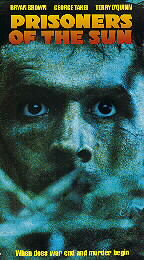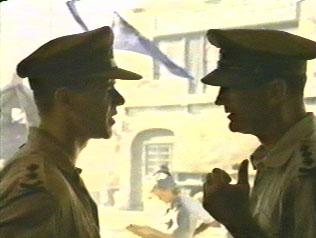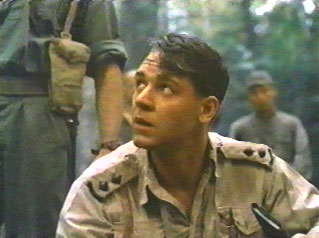
Director: Steven Wallace
Writers: Denis
Whitburn and Brian
A. Williams
Also stars: Bryan Brown (Captain Cooper), George Takei (Vice-Admiral
Baron Takahashi), John Polson (Private Jimmy Fenton), Ray
Barrett (President of the Bench), Toshi Shioya (Lt. Tanaka),
John Clark (Sheedy)
A few yards ahead of A Thin Red Line,
Prisoners of the Sun movingly depicts the savage
colors of war, the execution of honor, and the depressingly
predictable urge to self-aggrandizement. The film
tells the story of Australian war crime trials after World
War II. The arrogance of the "new world leaders",
matched with frantic clutching to tradition among the defeated
Japanese leadership, squeezes out any possibility of justice.
The remnants of honor can only be found on the sidelines.
 As
Bryan Brown's character says, "the future of the world
isn't worked out in a grand scale, it's worked out by ordinary
people doing their ordinary bloody jobs." While
the old boys network, American and Japanese alike, are "not
working out the future of the world... just preventing it
from being different to the past," small movements
from driven individuals shed some light on human potential.
This light is quickly snuffed in the person of a young ambassador
between traditions, the Japanese christian Signals Officer
leaves a sticky shadow on his superior, the Oxford-tutored
Japanese Admiral. This shadow darkens any glowing
ambitions the Allies have for their new world order. As
Bryan Brown's character says, "the future of the world
isn't worked out in a grand scale, it's worked out by ordinary
people doing their ordinary bloody jobs." While
the old boys network, American and Japanese alike, are "not
working out the future of the world... just preventing it
from being different to the past," small movements
from driven individuals shed some light on human potential.
This light is quickly snuffed in the person of a young ambassador
between traditions, the Japanese christian Signals Officer
leaves a sticky shadow on his superior, the Oxford-tutored
Japanese Admiral. This shadow darkens any glowing
ambitions the Allies have for their new world order.
The film is directed with intimacy.
Populated by a marvelous cast, the director (and
perhaps cameramen as well?) are devoted to their cast's
abilities to tell a story in expression and gesture.
If Crowe didn't have enough lines, his Lt. Jack Corbett
made up for it with those little true movements, those tidbits
of realism that contribute to the film's uncomfortable closeness
.
 The
grisly facts of the case do not leap out at you in the form
of blackened corpses. More imposing are the witnesses,
those at the disinterrment, and those in the hospital.
A profoundly disturbing story, the film is nevertheless
stout enough to handle the subject matter. The
grisly facts of the case do not leap out at you in the form
of blackened corpses. More imposing are the witnesses,
those at the disinterrment, and those in the hospital.
A profoundly disturbing story, the film is nevertheless
stout enough to handle the subject matter.
A curious post-script to my viewing
of this film: my mother remembered seeing it. And
here I looked and looked for a copy for weeks. I could
have just asked her how it was, since we agreed that it
was an unusually memorable film.
Thanks to the Crowe
Slide Shows for the two screen captures! |